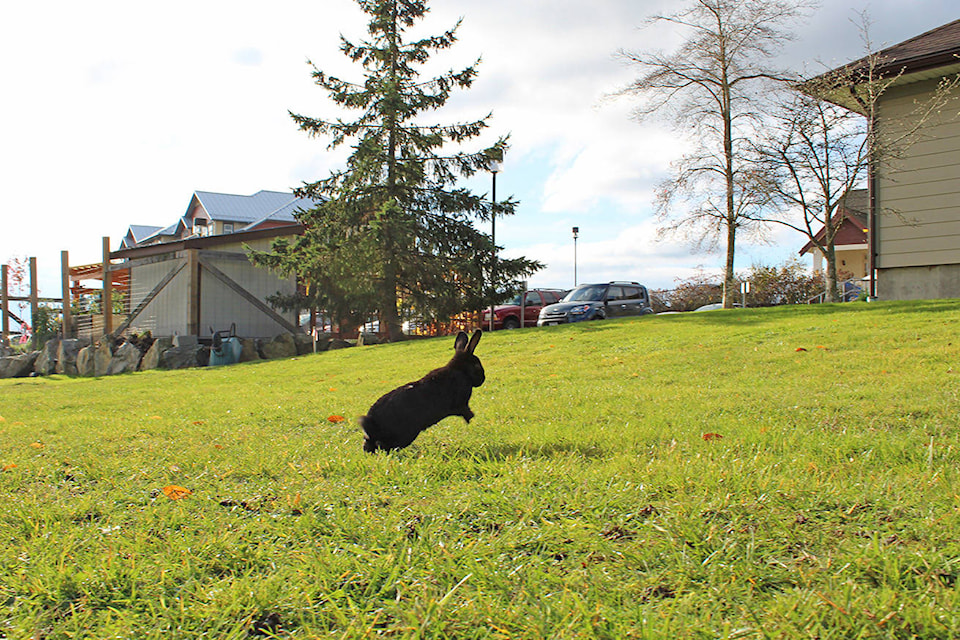The expansion of feral rabbits in Greater Victoria has reached Royal Oak.
And with the rabbits there are growing problems.
Within the last year a herd of about 10 of the wee hoppers has developed in Royal Oak and live between the Pat Bay Highway and the St. Vincent de Paul campus, feasting on the manicured grass of the latter.
It’s just one of the many rabbit herds in the region.
“They’re everywhere,” said Don Brown, CRD’s chief bylaw officer, which oversees the head of animal control. “It only takes a couple of pairs before you get [a herd of] 40 or 50. As the saying goes, ‘rabbits multiply like rabbits.’”
They’re known as feral rabbits for a reason. They’re not native to Canada and are the result of European rabbits brought to B.C. as pets, and then abandoned. As rabbits do, they multiply quickly with several gestation periods in a year.
They’re the rabbits that were famously once prolific at the University of Victoria before being culled and removed. They’re the rabbits that have pestered farms up and down the Peninsula and can be seen at various points along both the Galloping Goose and Lochside trails. They’re the rabbits that have frequented View Royal, famously crossing over to the Helmcken overpass meridian (removed as a health hazard in 2016), and now they’re spreading into other areas.
“The shelters are full of rabbits, there aren’t enough homes for rabbits. If people knew that maybe they’d educate themselves,” Sara Dubois, chief scientist, BC SPCA.
However, it’s rare that they’re culled (it has happened) and while it might seem as though they’re thriving, they’re not.
It’s only a matter of time before the rabbit hemorrhagic disease reaches the South Island. Earlier this year it was blamed for hundreds of deaths in Nanaimo and the Comox Valley. It’s had a similar effect in the Lower Mainland.
“It is very possible RHD will still be found in Greater Victoria in the future, and we are actually surprised it hasn’t already,” said Chief Scientific Officer, Dr. Sara Dubois. “We can only hope the virus does not spread more, as now people are aware of it and many have vaccinated their animals. But the ferals are still at risk, and many might not be discovered if they die in their warrens.”
RELATED: UVic officially rabbit free; Saanich mulls tougher rules for pet stores (2011)
The feral rabbits exist here only because of the warmer climates of the Lower Island and the Lower Mainland. Yet it’s not a glamorous life, which the SPCA Wild ARC learned while supporting the spaying and neutering of the Helmcken rabbits two years ago.
“We found the animals at Helmcken were in poor condition, the males were scratched from fighting and all the females were pregnant,” Dubois said. “It’s not a good life.”
If a rabbit (or rabbits) show up in your yard, don’t bother calling CRD animal control or the Saanich pound.
RELATED: Saanich bylaw could take aim at non-migratory Canada geese
They are deemed wild by the province. However, if they’re friendly and permit you to pet them or even pick them up, then Dubois suggests calling the local animal control or shelter. Yes, most local shelters are already full of rabbits, and there are not enough homes, but they strive to manage this phenomenon.
“If it was feral dogs, this would be taken care of, or even cats, but with rabbits we’re not quite there yet,” Dubois said. “What we see happen is there’s a group of rabbits in a park, and someone says, ‘well, we don’t have time for ours, so we’ll leave it with this batch.’ But that has to stop.”
Communities with escalating rabbit populations even partnered with the SPCA to get a UBCM moratorium on pet rabbit sales in B.C.
“If you are going to buy a pet rabbit, please be responsible and make sure it’s spayed or neutered,” Dubois said.
